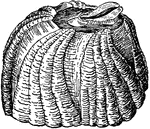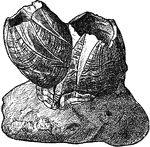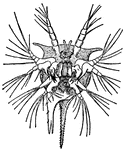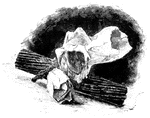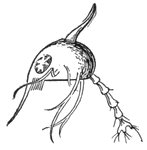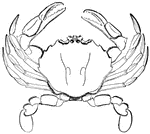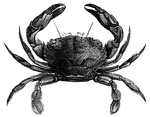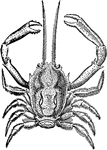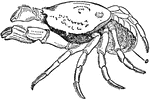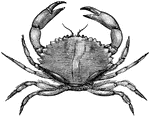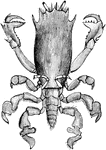The Crustaceans ClipArt gallery features 224 illustrations of crustacean species, such as crabs, lobsters, crayfish, and shrimp.
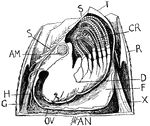
Acorn Shell
"Acorn-shell (Balanus tintinnabulum). T., tergum; CR., thoracic legs; R., outer shell in section; D.,…
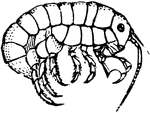
Amphipod
Amphipoda include over 7000 described species of small, shrimp-like crustaceans. Most amphipods are…

Amphipod
"An Amphipod (Caprella linearis). The two anterior thoracic segments are fused to the head; he abdomen…

Amphipoda
An order of sessile-eyed malacostracan crustaceans, with feet directed partly forwards and partly backwards.…
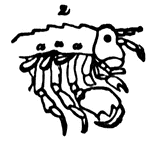
Amphipoda
An order of sessile-eyed malacostracan crustaceans, with feet directed partly forwards and partly backwards.…

Amphithoe
"A genus of amphipodous edriophthalmous crustaceans, of the family Corophiidæ."-Whitney, 1902
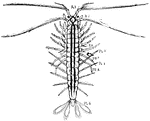
Anaspides
"Anaspides. A.1, A.2, antennae; Ex., rudimentary exopodite; G., respiratory lamina; PR.7, PR.8, seventh…

Apus Stages
"Three stages in the development of Apus. fs, frontal sensory organ; L, digestive gland; s, carapace;…
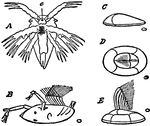
Early Stages of Balanus
An illustration showing the early stages of balanus: A, nauplis (larva); e, Eye; B, Cypris-larva with…

Barnacle
The Goose Barnacle has a body resembling a clam, attached by a soft, flexible stalk to some solid object.

Barnacle
"An animal of one of the lower orders. It fastens itself to some floating object and becomes glued to…

Goose Necked Barnacle
A species of goose necked barnacles, a crustacean known for attaching itself to objects and other animals.
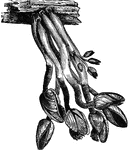
Barnacles
"The Common Barnacle, Lepas anatifera, perhaps the best-known example of the order, generally…

Barnacles
A white or brown arthropoda. Has a pair of cirri, which form a net used to scoop food particles out…

Blue Crab
"Several species of crabs are taken from Florida coastal waters, probably the most common being the…

Calymene
"The trilobite's general form is shown in the annexed figure of the Calymene Blumenbachii;…

Circulation of a Crustacean
Diagram of the circulation in a crustacean. Labels: a, branchial; b, somatic circulation. On the right…

Circulatory and Respiratory System of a Crayfish
Circulatory and respiratory system of the crayfish. C-heart with three pairs of ostia; Ps, pericardium;…

Cirolana Microphthalmia
Flabellifera are a type of isopod. Their bodies end in a tail fan, made by the last pair of appendages…

Lobster Claw
The pair of pincers or nippers, or te so-called claw, which terminates some of the limbs of most crustaceans,…
Copepod
Also known as fish lice, this is a species of copepod, a parasitic crustacean. "Female of Chondracathus…

Copepod
Also known as fish lice, this is a species of copepod, a parasitic crustacean. "Female of Chondracathus…

Copepoda
Copepoda, an order of Crustacea. A, cyclops quiadricornis; b, c, d, stages of growth in larvae.
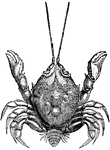
Corystes Cassivelaunus, female
"The anterior feet are about the length of the body. The other feet terminate in an elongated claw,…

Corystes Cassivelaunus, male
"The Long-clawed Crab is remarkable for its long antennae, which considerably exceed the length of the…

Crab
This illustration shows a crab, a species of cancer. Crabs are decapod crustaceans with thick exoskeletons.

Crab
"Transformations of the Crab: 1, young crab, or zoea, magnified; 2, young crab, in a more advanced stage,…
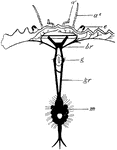
Shore Crab Nervous System
"Nervous system of shore-crab (Carcinus manas). br., The supra-oesophageal mass; g., gullet surrounded…

Shore Crab Zoaea
"Zoaea of common shore-crab (Carcinus manas). The appendages are numbered; c., gills; i., alimentary…
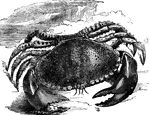
Common European crab
"These have the shell regularly rounded in front and narrowed behind; the legs are of moderate length,…

Dungeness Crab
The Dungeness crab is a species of crab that inhabits eelgrass beds and water bottoms from the Aleutian…
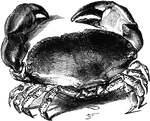
Edible Crab
The edible crab (Cancer pagurus) is a species of crab found in the North Sea, North Atlantic, and the…
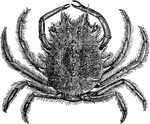
European Spider Crab
Maja squinado (the European spider crab, spiny spider crab or spinous spider crab) is a species of migratory…

Female Shore Crab
"Ventral aspect of femal shore crab. Abd., Abdomen; mxp., third maxillipede." -Thomson, 1916
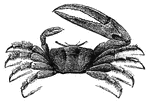
Fiddler Crab
A crab having one claw much larger than the other. As they walk sideways, they hold up the large claw…

Sand Fiddler Crab
The Sand Fiddler Crab (Uca pugilator) is a small crustacean in the Ocypodidae family of ghost and fiddler…
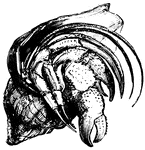
Hermit Crab
When alarmed, the hermit crab withdraws itself wholly into its portable house, closing the mouth of…
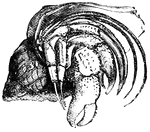
Hermit Crab
"When alarmed, the hermit crab withdraws itself wholly into its portable house, closing the mouth of…


